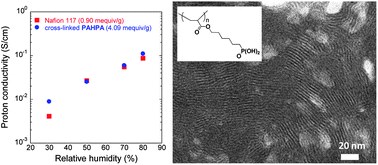Polymer electrolyte membrane based on polyacrylate with phosphonic acidvia long alkyl side chains†
Abstract
A series of novel phosphonated

Maintenance work is planned for Wednesday 1st May 2024 from 9:00am to 11:00am (BST).
During this time, the performance of our website may be affected - searches may run slowly and some pages may be temporarily unavailable. If this happens, please try refreshing your web browser or try waiting two to three minutes before trying again.
We apologise for any inconvenience this might cause and thank you for your patience.
* Corresponding authors
a
Department of Organic and Polymeric Materials, Graduate School of Science and Engineering, Tokyo Institute of Technology, 2-12-1 O-okayama, Meguro-ku, Tokyo 152-8552, Japan
E-mail:
ueda.m.ad@m.titech.ac.jp
Fax: +81-3-5734-2127
Tel: +81-3-5734-2127
b
PRESTO, Japan Science and Technology Agency (JST), 4-1-8 Honcho, Kawaguchi, Saitama 332-0012, Japan
E-mail:
thigashihara@polymer.titech.ac.jp
Fax: +81-3-5734-2126
Tel: +81-3-5734-2126
c
Department of Chemistry, Division of Advanced Materials Science, Pohang Accelerator Laboratory, Center for Electro-Photo Behaviors in Advanced Molecular Systems, Polymer Research Institute, and BK School of Molecular Science, Pohang University of Science and Technology (POSTECH), Pohang 790-784, Republic of Korea
E-mail:
ree@postech.ac.kr
Tel: +82-54-279-8143
d
Higashifuji Technical Center, Toyota Motor Corporation, 1200 Mishuku, Susono, Shizuoka 410-1193, Japan
E-mail:
satoshi@nakazawa.tec.toyota.co.jp
Fax: +81-55-997-7120
Tel: +81-55-997-9020
A series of novel phosphonated

 Please wait while we load your content...
Something went wrong. Try again?
Please wait while we load your content...
Something went wrong. Try again?
T. Higashihara, N. Fukuzaki, Y. Tamura, Y. Rho, K. Nakabayashi, S. Nakazawa, S. Murata, M. Ree and M. Ueda, J. Mater. Chem. A, 2013, 1, 1457 DOI: 10.1039/C2TA00537A
To request permission to reproduce material from this article, please go to the Copyright Clearance Center request page.
If you are an author contributing to an RSC publication, you do not need to request permission provided correct acknowledgement is given.
If you are the author of this article, you do not need to request permission to reproduce figures and diagrams provided correct acknowledgement is given. If you want to reproduce the whole article in a third-party publication (excluding your thesis/dissertation for which permission is not required) please go to the Copyright Clearance Center request page.
Read more about how to correctly acknowledge RSC content.
 Fetching data from CrossRef.
Fetching data from CrossRef.
This may take some time to load.
Loading related content
